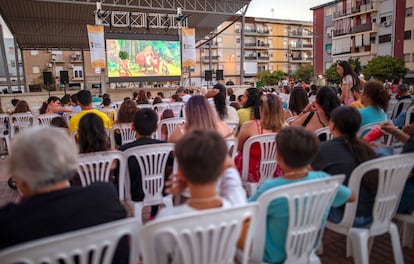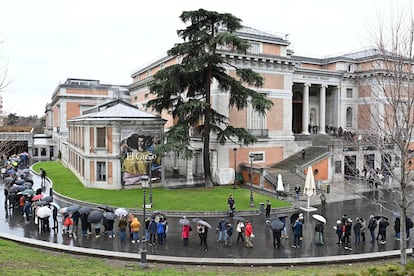The Ministry of Culture has released its blockbuster of the Legislature. “An identity sign, we believe that a milestone in Europe,” were definitions of Jasmine Beirak, in the presentation today Tuesday of the Cultural Rights Plan, after a year of elaboration. An unpublished project in the Administration, as well as its own position, created for this mission: General Director of Cultural Rights. Through a 79 million endowment (46 of new investment), 146 measures and a two -speed short -term horizon, by 2027; The others, by 2030 -, the Ministry intends to remove and rethink public action in the sector, to alleviate the eternal inequalities of access, participation and creation, combat censorship, interference and precariousness or improve the citizen perception of the arts. That it is really fulfilled, in short, article 44 of the Constitution: “Public powers will promote and protect access to culture, to which everyone is entitled.” Ambition is unquestionable. Doubts surround the continuity of the government itself, the concrete impact on the life of citizenship or the collaboration of the Autonomous Communities.
Eight decades ago, in reality, that the Universal Declaration of Human Rights included cultural. Rarely, however, those words have transcended those old roles. In the theory, it is that all the actions of the administration promote rights such as author, access, creation, freedom of expression, participation in activities and policies to constitute them, traditional and popular cultures, historical memory or the own cultural identity of each one. The practice of the plan presented today, for the moment, proposes to expand the discounts for access to state museums or theaters to groups such as single -parent families, allocates more aid to projects in schools or in the rural environment and ratifies gender criteria in subsidies. In addition, draft changes as a new Cultural Rights Law are promised, that Navarra already has for example and that he was in the government pact between PSOE and add, although he has not been carried out; Modifications in other regulations, such as the Criminal Code or the Public Sector Contract Law (by 2026), or greater links between culture and education, mental health, sustainability or diversity. “It is a state project, of the Ministry, not a party. It has already taken long to start, it should continue,” said Beirak.
“It is very important for Spain to recognize our rights regarding the cultural framework,” said Alexandra Xanthaki, a special reporting of the UN for this area, in a video issued in the act, in the Reina Sofía Museum in Madrid, before dozens of representatives of the artistic sector and other ministries. His presence endorsed the plan and, at the same time, he remembered that he is also his. Rather, of all, in the intentions of culture. Beirak estimated that 80% of the measures come from contributions in the sector, which participated in the previous works with more than 300 experts, entities, working groups gathered around 13 axes, interviews or about 1,000 proposals of citizenship. “We are not alone in this,” said the general director, underlining the involvement of the rest of the Executive, as well as some autonomous communities.
To date, however, only six (Canary Islands, Murcia, Asturias, Aragon, Catalonia and the Basque Country) have sent contributions or documents. On his collaboration, and the most motionless and faced Congress of the last five years, a few measures depend. Although most actions, according to Beirak, are “executive.” That is, it is in the hands of culture. And the “80%” of the money planned for this year is already in process or directly invested.
From the budget, 66 million are intended for aid, such as million for professional associations and unions in the sector, or the four for special social impact projects. The director also promised follow -up: an intermediate evaluation, in 2027, and another end, in 2030. Her hope is that, then, not only the plan follows, but also renews, until normality becomes normal. “An update of cultural policies in Spain was needed. And one of the things that most proud of this plan is its long -term vision. The day to day is eaten in the management of a ministry, the needs are immense, and you run the risk that you are not able to think strategically to 20 years seen,” celebrated the Minister of Culture, Ernest Urtasun. The future will say. The truth, for now, is that every day in Spanish politics it throws surprises and shocks and the government has a hard time adding support for almost any initiative.
Waiting to know where it is going, the plan is clear where it comes from. First, there were months of diagnosis. And some of the 146 measures foresee the realization of more reports: a White Paper of Cultural Rights, a study on ethnic-racial diversity, another on inequalities in participation, on the social perception of culture … although the official statistics of the Ministry have been offering clues about it for years: assistance in fields such as cinema, live events (music, scenic arts …) or museums, galleries and exhibition half of Spain. Gender, level of studies, place of origin and residence, disabilities, purchasing power or age have erected as unwavering barriers to cultural rights.
Inequalities
“It is probably one of the fields with the most inequality and where you least attend,” said Beirak. Citizens with higher education or equivalent go to cinemas, theaters or concerts and read twice the one who did not go from the most basic studies. Practically, all artistic activities, except opera or classical music, record the greatest participation between 15 and 24 years. From there, consumption goes down, to free fall from 55 or 65, depending on the scope. At the same time, the beneficiaries of the Young Cultural Bonus, the 400 euros that the Government gives for arts spending to whom they turn 18, are abruptly reduced in the foreign and rural population.
Individual investment in culture shows practically identical biases. And the same obstacles that include participation condition the creation: Andalusia, Catalonia and Madrid represent 48.57% of the Spanish population, but host 62.5% of popular music concerts, more than half of the rooms, companies, representations, public and theater collection, as well as cinemas, among other examples. On the contrary, there are regions – or more simply peripheries – where it costs to find offer, or even billboard. And the complaints that only the children of the elite can really devote themselves to the arts, especially to the cinema, sound increasingly recurring. What is reflected in the stories that culture tells. And that reinforce the same exclusions. “Black people are not going to see monologues because there comes a time when the light comes on and you become the joke,” summarized the humorist Asaari Bibang Ngui, presenter of the act.

All this aspires to solve the cultural rights plan. With a culture training course for teachers; the update of the museums of America and anthropology; the recognition of Caló and El Romaní with its inclusion in the European Charter; a project to take cinema to rural municipalities; a code of good practices within the Ministry itself; the unit of attention and prevention of sexist violence and more proposals. “It is a great plan that establishes a framework, but with many concrete actions after identifying the barriers that prevent culture from being considered a fundamental right of citizenship. To combat gender gaps and inequality. To defend our diversity with nails and teeth,” Urtasun added.
Among many specific obstacles, the initiative must overcome another more general. He wants to include a citizenship that, as the document himself recognizes, usually turns his back on him. “In the set of concerns of society, culture issues are not perceived as relevant or urgent,” reads the text. “It’s one of the big problems,” Bairak admitted. Although considering that cultural policies themselves have contributed to away the population and that the improvements of the plan can also be reflected in that aspect. After all, the project needs the same as any cultural creation: an interested audience.

